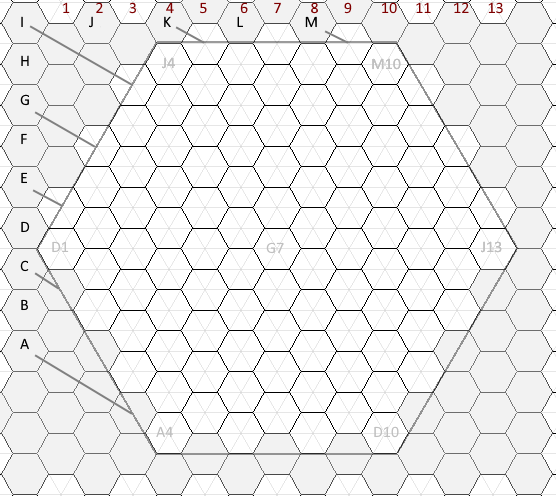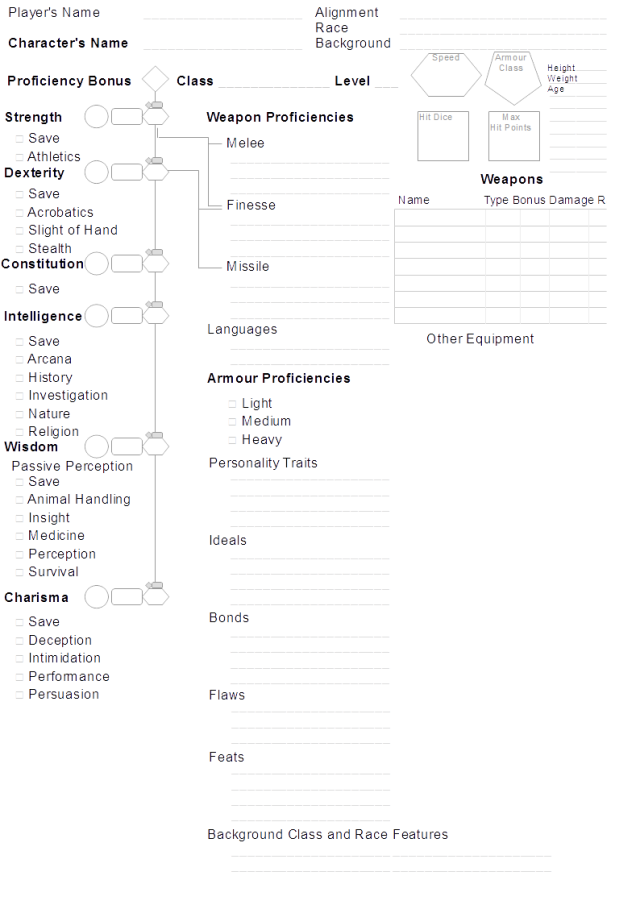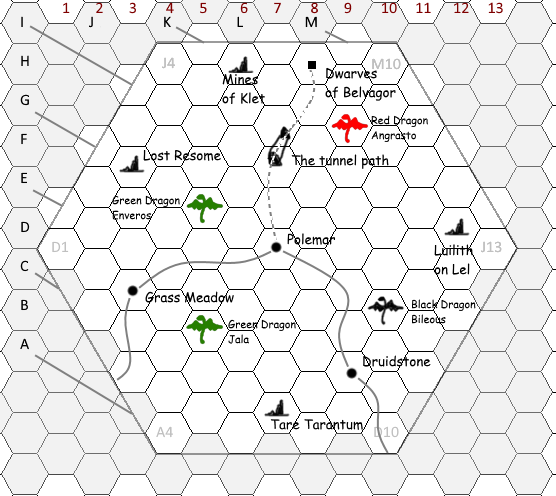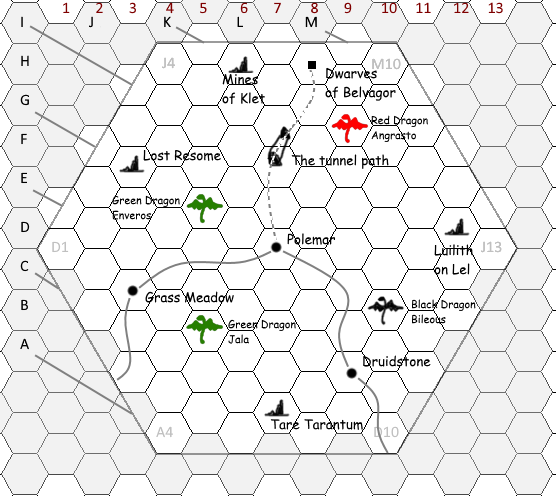| Spoiler Alert: If you are a player in the open table games you should not read this if you do not wish to spoil any sense of suspense, or to lesson the enjoyment of revelation during exploration. You have been warned. |
This year I am creating a campaign for Dungeons and Dragons 5th edition that is designed for open table play. To understand what that means I suggest you peruse The Open Table Manifesto and later Public Open Table Basics.
Here I intend to show my development of that campaign and the items I produce to support play. When I’m finished I intend to package up the end result in a pdf available through my Patreon account for anyone that wants to use it themselves.
So here are the first things I have done.
Mapping The Play Area
I have created a hex grid blank that I can use for the hex crawl aspect of my game. You will note that this grid is designed to scale up and down with hexes inside hexes.

My base scale will be 10 miles to the hex and some hexes I intend to map internally at a detail of 1 mile per hex. Some of those I will map at 1/10 of a mile per hex (176 yards). Note that a cottage occupies roughly 10 by 10 yards, so you could fit a hamlet of 100 cottages into a single 1/10 mile hex. That means that some locations I may map down to 17 yards per hex, but more likely I will swap to a scale of 5 or 10 feet per grid element (hex or square) where it is useful to do so. Generally for cities and towns I draw loosely scaled mud maps, often without individual buildings or streets but rather precincts, main thoroughfares and the occasional special point of interest such as a market, smithy, tavern, inn, temple, knight’s keep, fort and so on.
For now I will focus on my 10 mile to the hex scale. At this scale I have decided that every hex will have an “encounter”, either a creature or a landmark, town, or “dungeon”.
Time
The player “home base” will be the central hex, making the edge of the larger hexagon about 2 days travel by road, which is enough for the campaign. I will be playing once a fortnight and each session will begin on the actual date of the session. Adventures generally wont be allowed to go over two weeks of in game time, so players will get back home with some days to spare before the start of the next session. I am going to use my rules for treasure sets so experience gained is flowed in to the character over time and the use of treasure found will be divided between lifestyle and upkeep, experience conversion and whatever other uses can be found for such wealth.
Seasons will be basically the same as we are experiencing when we play. Being in Queensland, Australia that means sweltering summers in January and cool, wet winters in July.
Setting Overview
My rough idea for the setting is that dragons dominate the landscape. Each dragon projects its presence in a 12 mile radius about its lair. The dragons have a culture and can build things but they prefer to get their food/slaves to do that for them. Dwarves have a thriving culture in mountains to the north but they are constantly under the eye of a red dragon that is always demanding tribute and occasionally extracting a “toll” from trade caravans that try to move south to the human towns.
The humans who have a more established civilisation far to the south have a frontier here that has to pay tithes to several green and black dragons in the region.
The elves once had an extensive empire across the region but it fell to the dragons centuries ago, and the elves remain cranky and conspiratorial in their arboreal homes. They dislike the dwarves and disrespect and mistrust the humans. Much of the ruins and “dungeons” are of elvish origin, though some are dwarvish and a very few are draconic.
There are factions in each group driving action, although this is intentionally set up to be a bit of a pot boiler, so actual change will be slow to come from that source. That means that players can miss several sessions at a time and still have a handle on how things are when they return. Nevertheless player actions may still effect noticeable change and will be the main way that that occurs, not factional behaviour.
The supernatural world is divided into the demons and celestials at the bottom, then the gods and above them the forces. These entities are considered real and religions riff of their existence, revering groups or factions among the gods and forces. Gods derive their strength of existence and happiness by the worshipping and tithes of mortals and much struggle between the gods is competition over these “foods”. The forces control deeper aspects of nature and resent the gods who have more autonomy and often “hurt” the forces by changing how things happen and manipulating the forces for their own ends.
Dragons worship gods as much as anyone else and some dragons may be clerical in nature although there is no draconic overarching religion. The dwarves align with gods and forces of the underworld and earth. Elves like nature and sky and astronomical things. Lots of elves are druids.
Barbarians are remnant human and elf groups that became cut off from their civilisations and formed primitive nomadic tribes, of which there are maybe three in the region mapped.
General Encounters
As players traverse the world there will be encounter rolls at regular intervals. They can summon weather events, location events, creatures or evidence of creatures from nearby keyed lairs (projections), or random, location appropriate encounters. Creatures encountered will not just be combat encounters. They will have a context and be about whatever their business is, which may turn to combat. Players wont get surprised by deadly encounters that are intent on total party kills, that just wont happen no matter what. If the players are encountering something that could kill them all and they know it and insist on poking it with sticks then some characters are going to die or the party will be punished in some way (possessions confiscated, loved ones held to ransom and so on). Of course they could always get lucky and prevail.
Rules Thoughts
The 5e hit point recovery is based around keeping players fully active, so they bounce back quickly from even a zero hit point situation. I have never really liked that, as it seems to detract from some of the sense of “attainment against heavy odds” that can be very pleasing for players. I tend to use a rule that being taken to zero hit points will take you to 1 point of exhaustion if you don’t already have any exhaustion. Each death save that is failed adds a point of exhaustion. In this system you die if your exhaustion gets to 6, instead of 3 failed death saves. 3 successful death saves return you to 1 hp as usual, as does being stabilised by someone else, but the exhaustion remains and hampers the character until healed. Magical healing can fix exhaustion on a 1 exhaustion for 1 hit point basis. This actually works nicely with the “real time passing” nature of the campaign.
At the start of a session, players who have existing characters will have to account for their lifestyle and upkeep since the date of their last adventuring day. Many days of low lifestyle should have a chance of leaving a character not so well off at the start of play. Perhaps some exhaustion, a loss of gear due to theft and so on. High lifestyles have to be paid for but may see the player starting the session with some kind of boon, contacts, knowledge, extra equipment, robust health, inspiration or whatever. I haven’t worked that all out yet but I won’t be under much pressure for that until my second session is looming.
Clerics will have a duty to hold ceremonies and bring worshippers to them fairly regularly. I’m thinking that the common ceremonies just require the cleric to do daily prayer. Some weekly ceremony needs more worshippers and a holy place like a shrine. Monthly ones need a chapel and quarterly or yearly ones need temples. These ceremonies open up the ability to use higher level spell slots over the period covered. So 1st to 3rd for daily prayer, 4th to 5th for weekly ceremonies that give the ability to use those slots for a week, and enables their regeneration after the usual long rest. 6th to 7th for the monthly ones and the rarer ones cover 8th and 9th level spell slots. This allows special holy places and artefacts that grant easier access to spell slots and makes religion a bit more rich mechanically. This also works in with the “real time tracking” process although it won’t effect play until there are characters able to use 4th level spell slots or higher.
I have also started work on a character sheet that is hopefully quicker to fill out and understand by novice players.
Here is my first draft of that:


I’ll include the full thing with fill out instructions as a pdf in the final package after its been given a lot more play testing.
Map Basics
Ok, here are the first map elements on a quick sketch:


Nice.. A good read.
Interestingly, the mini campaign world that Tara and I are working on is sort of based on Dragons too.
The campaign area is completely surrounded by nigh on impassable mountain ranges.
In each major compass point lives an ancient huge Dragon based on one of the 4 elements (Air, water, Fire Earth).
In the centre of the campaign area is a huge column of earth and Rock ascending miles into the sky.
Some cataclysmic event caused it and the 4 Dragons came into being when it happened.
Surrounding the column of rock is a donut shaped huge Freshwater lake and around that is the landmass where Humanoids live.
Surrounding that is the said Mountain range.
In addition to that, upon Tara’s request, there’s no Orcs or Goblins in this world.
But there are Dragon born, which are largely evil.
Oh and there are Kobolds (related to Dragons), but with more variety as detailed in Volo’s guide to monsters.
Actually I’m using this world to run that adventure over this weekend. 🙂
LikeLike
My reason for having dragons in charge of large territories is that I always liked the Dragonlance series (very linear but I broke it up into a slightly more networked adventure) but it starts off with dragons absent from the world. Most stories with dragons in them seem to have just one dragon somewhere. I felt like going to a world where dragons have their natural dominion so to speak.
LikeLike
OK yeah I remember reading the books many years ago.. Good fun.
I/we went with using Dragons as TBH, I have hardly ever used Dragons in RPGs in the past, so I wanted to make them a big part of a custom campaign world this time.
LikeLike
A new character sheet is a good idea too. The current “official” ones are ok.
But it’s nice you’ve incorporated some of the rules guidelines in the sheet itself.
LikeLike
I always felt that gm screens need a lot of player relevant cheat sheet and it has occurred to me lately that player’s need the equivalent of a gm screen, so yes this as a step toward that.
I’m also working on a character creation quick reference so we can get new characters off the ground real quick. It will come with very limited choices compared to the full on players hand book though.
In the attributes area I have a spot for attribute value, attribute raw DM, and attribute DM combined with proficiency bonus. The skills under each attribute use the combined value if proficiency is ticked, otherwise the raw DM. Lots less writing when creating the character and also a visual guide as to how the numbers interact for new players.
LikeLiked by 1 person
I agree, a cheat sheet for players is a great idea. It takes unnecessary work away from the GM when players have reference material like that.
Regarding a quick character gen sheet. I did notice on the Wizards, DnD 5e site, there’s a section called “Unearthed arcana” (Homage to the old 1st Ed Unearthed Arcana book), which has lots of optional rules and there’s a section with a quick character gen sheet. You should take a look.
LikeLike
I’ll take a look. Part way through creating a “how to make a character” cheat sheet.
LikeLike
Pingback: Constructing an Open Table Campaign for D&D 5e part 2 – Strange Flight
Your character sheet is exactly what I’ve been looking for for a while. I might steal it and print it for my own campaign. There’s so many good ideas here, thank you for posting.
LikeLike
Your welcome. Some ideas not yet implemented:
include the attribute DM lookup
include the experience for level lookup
make a specific variation of the second page for different classes – particularly spell casting styles
add a single rules cheat sheet for the main player facing mechanics
LikeLike